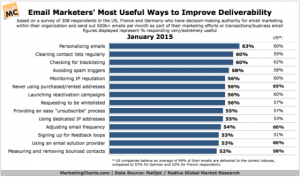The main goal of marketing is to get prospects to find you, and then convert through every stage of the funnel on their way to becoming a customer. No two customer journeys are exactly the same and with so many potential routes, it can seem like an overwhelming task to optimize the process.
This post will walk marketers through multiple steps they can take to improve full funnel conversion rates.

1. Listen to Your Sales Team
As the age-old story goes, marketers fill the funnel with tons of leads and it’s Sales’ job to close them. When the company fails to hit its customer quota for the month, Sales blames Marketing for delivering bad leads and Marketing blames Sales for low win rates.
Change happens when teams stop blaming and start listening.
If Sales says that the leads they are receiving are low quality, work with them to define parameters that would make them “high quality.” Once those are defined, Marketing can begin testing, tracking and optimizing for quality as well as quantity.
If you’re attracting a ton of leads at the top of the funnel, but they’re unqualified and highly unlikely to purchase your product, conversion rates will suffer. These leads will never convert past the discovery stage.
Instead of a leads goal, marketers should instead focus on delivering the best possible leads to Sales.
Tracking Notables: What interactions deem a lead as “qualified”? What channels have the highest conversion rates?
2. Lead Grading
One of the best ways Marketing can track the quality of the leads they drive, is by setting up a lead grading system. Based on demographic and firmographic details, matched with historical customer data of what types of companies become customers leads can be given an A, B, C, D, or F grade, which in turn tells the sales and marketing teams how likely they are to turn into a customer.
With this process in place, you can add in the additional perk of being able to track the quality of leads that convert, not simply just that x amount of leads are converting.
For example, say you host a webinar on X topic and a week later host one on Y topic. Both webinars received 100 registrations. It would seem that they were equally as good. However, if you had a lead grading system in place, you could segment the data by grade. In this format, you can see that registrants of webinar X were primarily A leads, with a few Bs and webinar Y drove primarily C grades, with a few Bs. Naturally, you’d come to the conclusion that webinar X was more successful than webinar Y.
Through tracking and optimizing, marketers are able to fill the funnel with more A and B grade leads and in turn improve full funnel conversion rates because the funnel is now filled with high-quality prospects that are more likely to convert into customers.
Tracking Notables: What channels are driving A & B grade leads? What channels are driving D & F grade leads? Which content is converting A, B, & C grades?
3. Listen to the Customer (Data)
Marketing attribution provides a single source of truth so that marketers can make decisions on accurate, reliable data. Because it tracks every touchpoint, from every lead, no matter the channel, it provides marketers with a unique view into the entire customer journey.
Tracking allows you to pinpoint the areas that marketing needs to improve. For example, if A and B grade prospects are falling off at an unusually high rate in the middle of the funnel, you know you need to refine the MOFU process. What CTAs, channels, content, emails etc. are you feeding to the middle of the funnel? What can you do to improve each of those so that prospects continue to engage and convert?
When you have attribution data on the full funnel, you can use it to predict how prospects will likely flow through the funnel in the future. Historical rates matter because they give you a point of comparison for all future optimizations (did the change I just made hurt or improve performance?) and give you a head’s up of what to expect in the future (data shows that past leads have an average of 5 touchpoints before they convert to opportunities).
Tracking Notables: How many days are in the typical sales cycle? How many touchpoints occur before a closed deal? How many people do you interact with from a single company?
4. Target the Right Personas
When you start listening to your customer data, you’ll begin to notice trends in the buying journey. The B2B sales and marketing process can span months and typically includes touchpoints from multiple contacts within a single account.
Tracking all of that data allows you to personalize the user experience. You’ll discover which personas the researchers are, and the users of your product, and the decision makers. That information is extremely valuable because it allows marketers to target the right persona at the right time.
If it’s uncovered that the CMO is the decision maker, you’d want to create CMO-specific BOFU content, or if the Paid Search Manager is the researcher you’d create educational content directed toward paid search.
When prospects visit your site and consume relevant, valuable content, they’re more likely to convert.
Tracking Notables: How many personas play a role in the buying journey? Which personas are they? Which channels have the highest conversion rate for each persona?
5. Track Through to Closed Revenue
Lastly, and possibly the most important step, is to track all touchpoints to revenue. Metrics like click-through-rate (CTR) and cost-per-lead (CPL) are important metrics, but when looked at singularly they don’t tell the whole story.
For example, say you do a test and Campaign X has a CTR of 20%, while Campaign Y has a CTR of 10%, if you were only looking at those numbers, you’d kill Campaign Y and move forward with Campaign X because more people are clicking through.
However, if you continue to track both of those campaigns through to revenue, you may discover that Campaign Y drove $ 60,000 in revenue, while Campaign X only drove $ 20,000 in revenue. If you made your decision on CTR alone, you would have missed out on 3x more revenue.
As marketers, it’s much more valuable to say you drove X amount of revenue, than you drove X amount of conversions.
Tracking Notables: How much revenue did your campaign drive? What is the ROI of your campaign?
Conclusion
Improving conversion rates, means improving the success of Marketing. But you can’t simply get anyone to click your CTAs or fill out your forms to be successful, improving full funnel conversions rates means converting quality leads that go on to become customers.
Business & Finance Articles on Business 2 Community
(32)






